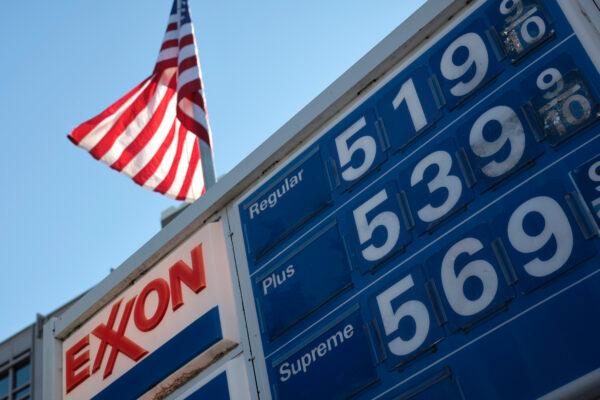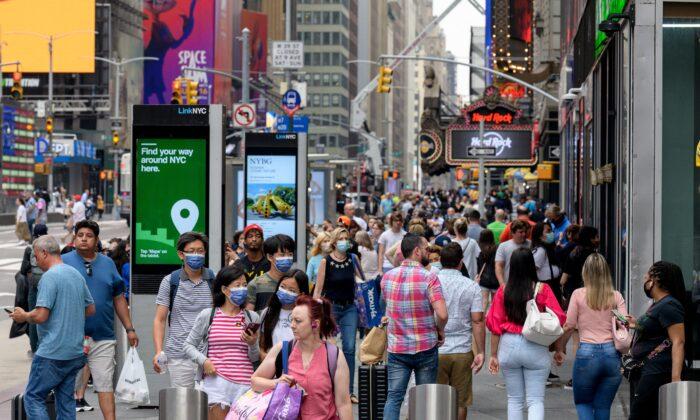U.S. inflation accelerated to an 8.5 percent annual rate in March, heightening fears of a recession.
Some economists believe that regaining control of prices will require far more aggressive rate increases by the Federal Reserve, which may topple the U.S. economy into a recession.
Wall Street analysts are already projecting a downturn for next year. Last week, Deutsche Bank became the first large bank to foresee a recession in 2023. The further Fed tightening is projected to have a significant impact on the U.S. economy by late next year and early 2024, according to the bank.
Bank of America has a similarly pessimistic outlook. Chief investment strategist Michael Hartnett stated in a recent note that the Fed’s belated response to “out-of-control inflation” would lead to a recession. In one sentence, he summed up the bank’s position: “‘Inflation shock’ worsening, ‘rates shock’ just beginning, ‘recession shock’ coming.”
High inflation, according to many, is a product of Washington’s policy decisions, which include excessive government stimulus spending and the Fed’s “money printing.”
“My expectation is that we are close to a peak in inflation, but that inflation will remain uncomfortably high for the next few months,” Desmond Lachman, economist and senior fellow at the American Enterprise Institute, told The Epoch Times.
The bond market, Lachman noted, which has inverted the yield curve, is correct in anticipating that inflation will moderate because Fed tightening will trigger a recession.
“In fact, I think that there is a real risk that the U.S. economy could have a very hard landing if higher U.S. interest rates burst the current equity, housing, and credit market bubble. In that case, we could be back to a situation of a very weak economy and rapidly decelerating inflation by early 2023,” Lachman said.
“All of this does not bode well for the Democrats’ prospects in the midterm elections since, by November, the economy could be in a dreaded state of stagflation.”
New Threats
Current wage pressures and rising rents, according to Lachman, would continue to keep inflation high and make the Fed’s fight more difficult.China’s COVID-19 restrictions are also posing a new threat to the global supply chains. The Chinese regime’s strict “zero-COVID” policy has prompted fresh lockdowns in major cities, including Shanghai. This is expected to intensify global supply disruptions and add to inflationary pressures on goods and raw materials imported from China.
A decline in oil prices because of a drop in Chinese demand also is expected to be temporary. While analysts believe the Biden administration’s recent actions on oil will bring some relief to consumers at the pump, they anticipate crude oil prices to surge over the 12-month horizon.

The Biden administration recently authorized a “historic release” from U.S. petroleum reserves and has approved the use of affordable E15 gasoline in the summer.
These actions won’t have the desired impact on gas prices, according to Phil Flynn, senior energy analyst at the Price Future Group.
Releasing oil from strategic reserves is “like taking alcohol as a pain reliever. It may seem like a good idea now, but you will end up with a heck of a hangover,” he wrote in a recent note.
Following last week’s drop, oil prices have begun to rise again, owing to optimism that Chinese demand would soon recover and OPEC warnings that replacing Russian oil exports would be impossible.
Meanwhile, global food prices have risen at their fastest pace on record.
The Russian invasion of Ukraine has created significant uncertainty and volatility in global commodity markets, particularly in agricultural commodities. The United Nations’ Food and Agriculture Organization said that its food price index in March climbed 13 percent, reaching an all-time high. Vegetable oil, grains, and meat prices, in particular, soared to unprecedented levels.
The crisis in Eastern Europe and the sanctions on Russia are making the food supply chain more vulnerable. Russia and Ukraine together produce over a third of the world’s wheat. In addition, Russia’s decision to halt fertilizer exports for the remainder of 2022 is expected to exacerbate the problems faced by U.S. producers.
The crisis in Ukraine and its impact on commodities pose immediate challenges to U.S. consumers and the economy, according to Luke Tilley, chief economist at Wilmington Trust.

U.S. consumer sentiment indexes have dropped to “extremely low” levels, and this suggests consumer spending will slow going forward, he told The Epoch Times.
Tilley expects the Federal Reserve to be aggressive over the next couple of months. However, he forecasts that when inflation and the economy decline in the second half of the year, Fed policymakers will need to take a step back from their aggressive posture.
This could prevent a hard landing for the economy.
The port congestions have also improved dramatically. Drewry’s World Container Index shows that the cost of shipping a container has fallen more than 20 percent since its peak in September of last year, he noted. In addition, while wages continue to grow, the pace of increase has cooled over the past three months.
“However, I think inflation is highly unpredictable,” Tilley said.
“There’s certainly a lot of risk that inflation could keep rising,” he said, compelling the Federal Reserve to move more aggressively to contain it.





